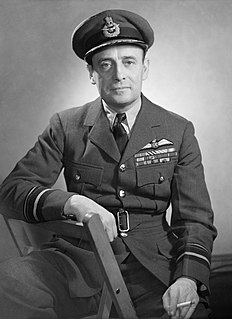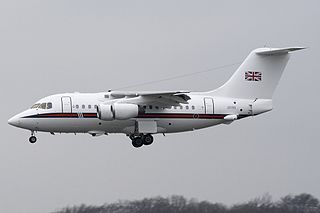
Air Chief Marshal Sir Trafford Leigh-Mallory, was a senior commander in the Royal Air Force. Leigh-Mallory served as a Royal Flying Corps pilot and squadron commander during the First World War. Remaining in the newly formed RAF after the war, Leigh-Mallory served in a variety of staff and training appointments throughout the 1920s and 1930s.

Marshal of the Royal Air Force Arthur William Tedder, 1st Baron Tedder, was a senior Royal Air Force commander. He was a pilot and squadron commander in the Royal Flying Corps in the First World War and he went on to serve as a senior officer in the Royal Air Force during the inter-war years when he served in Turkey, Great Britain and the Far East. During the Second World War, as Air Officer Commanding RAF Middle East Command, Tedder directed air operations in the Mediterranean and North Africa, including the evacuation of Crete and Operation Crusader in North Africa. His bombing tactics became known as the "Tedder Carpet". Later in the war Tedder took command of Mediterranean Air Command and in that role was closely involved in the planning of the Allied invasion of Sicily and then the Allied invasion of Italy. When Operation Overlord—the invasion of France—came to be planned, Tedder was appointed Deputy Supreme Commander at Supreme Headquarters Allied Expeditionary Force under General Eisenhower. After the war he served as Chief of the Air Staff, in which role he advocated increased recruiting in the face of many airmen leaving the service, doubled the size of RAF Fighter Command and implemented arrangements for the Berlin Airlift in 1948. After the war he held senior positions in business and academia.

No. 12 Group of the Royal Air Force was a command organization that existed over two separate periods, namely the end of World War I when it had a training function and from just prior to World War II until the early 1960s when it was tasked with an air defence role.

Marshal of the Royal Air Force Sir William Forster Dickson, was a Royal Naval Air Service aviator during the First World War, a senior officer in the Royal Air Force during the inter-war years and a Royal Air Force commander during and after the Second World War. Dickson was Chief of the Air Staff in the mid-1950s, in which role his main preoccupation was the establishment of the V Force and the necessary supporting weapons, airfields and personnel. He also served as the first Chief of the Defence Staff in the late 1950s.

Air Chief Marshal Sir Roderic Maxwell Hill, was a senior Royal Air Force commander during the Second World War. He was a former Rector of Imperial College and Vice-Chancellor of London University. The Department of Aeronautics of Imperial College is situated in a building named after him.

Air Chief Marshal Sir James Milne Robb, was a senior Royal Air Force commander. After early service in the First World War with the Northumberland Fusiliers, Robb joined the Royal Flying Corps and became a flying ace credited with seven aerial victories. He was granted a permanent commission in the Royal Air Force in 1919 and commanded No. 30 Squadron RAF in the Iraqi revolt against the British. In 1939, Robb travelled to Canada to help establish the Empire Air Training Scheme, a massive training program that provided the Royal Air Force with trained aircrew from Canada, Australia, New Zealand and Southern Rhodesia. He commanded No. 2 Group RAF of RAF Bomber Command and No. 15 Group RAF of RAF Coastal Command.
Air Vice Marshal Sidney Osborne Bufton, was a senior commander in the Royal Air Force during the middle part of the 20th century. He played a major part in establishing the Pathfinder project, over the objections of Arthur Harris.
Air Vice Marshal Edgar James Kingston-McCloughry,, born Edgar James McCloughry, was an Australian fighter pilot and flying ace of the First World War, and a senior commander in the Royal Air Force during the Second World War. He shot down 21 aircraft and military balloons during the former war, making him the 6th highest-scoring Australian ace. He was also awarded the Distinguished Service Order and the Distinguished Flying Cross and Bar as well as being Mentioned in Despatches.

Air Chief Marshal Sir Charles Stuart Burnett, was a senior commander in the Royal Air Force during the first half of the 20th century. He was Air Officer Commanding Iraq Command during the early 1930s. During the Second World War, he served as Chief of the Air Staff of the Royal Australian Air Force.

Air Vice Marshal Sir Geoffrey Rhodes Bromet was a senior Royal Air Force (RAF) officer during the Second World War and Lieutenant Governor of the Isle of Man from 1945 to 1952.

Air Vice Marshal Richard Ernest Saul, was a pilot during the First World War and a senior Royal Air Force commander during the Second World War.
No. 18 Group of the Royal Air Force was a group active from 1918 to 1919, and from 1938 to 1996.
Air Vice Marshal Sir Alan Hunter Cachemaille Boxer was a senior Royal Air Force officer.
Air Vice Marshal Henry Meyrick Cave-Browne-Cave was an engineering officer in the Royal Naval Air Service during the First World War and senior commander in the Royal Air Force during the 1930s.

Harry George Smart, is best known as the commander of RAF Habbaniya during the first part of the Anglo-Iraqi War. Smart was an officer in the British Army, the Royal Flying Corps and the Royal Air Force. He served during the First World War, during the interwar period, and during the Second World War.

Middle East Command was a command of the Royal Air Force (RAF) that was active during the Second World War. It had been preceded by RAF Middle East, which was established in 1918 by the redesignation of HQ Royal Flying Corps Middle East that had been activated in 1917 although a small Royal Flying Corps presence had been operational in the region since 1914.

Air Vice Marshal Wilfred Ashton McClaughry,, born Wilfred Ashton McCloughry, was an Australian aviator and air commander who served in the Australian Flying Corps during the First World War and Royal Air Force in the Second World War. His senior commands included: British Forces Aden (1930s), and; No. 9 Group RAF, and Air Officer Commanding Air Officer Commanding Allied Headquarters Egypt. McClaughry was killed, while a passenger, in a flying accident in Cairo in 1943.
Air Vice Marshal Francis Frederic "Frank" Inglis, was an officer in the Royal Air Force who became the head of RAF Intelligence Staff during the Second World War, reporting to Winston Churchill. In 1942 he was sent to America, where he successfully persuaded President Franklin D. Roosevelt to direct the main American war effort against Germany rather than Japan.

Air Vice Marshal Brian Courtenay Yarde, was a Royal Air Force officer during the Second World War and a senior commander in the 1950s.



















